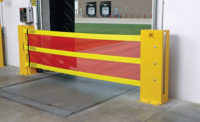Turn your safety overheads into productivity and profit

For most industries, safety is a cost overhead. Although essential, it can slow down productivity or even, in the event of a safety incident, lead to a complete stop while issues are resolved, and investigations carried out. However, if the approach to safety changes from a reactive one to proactive, where instead of reducing the impact of accidents they are prevented, it can become an aid to achieving greater efficiency, lower costs, and higher profit margins.
This may sound like a simple statement, but the question is “how?” How can the inevitable risks to personnel and other assets across factories, construction sites and other work environments be better managed to prevent incidents occurring? How can vehicles be allowed to go faster and the risk to pedestrians be lowered? If we can achieve both things, efficiency and value, not cost, becomes an integral part of the safety equation.
Connecting safety into operations
In a world of increasing automation, connectivity and data, there is potential for a sea change in the way we approach safety. Technological tools hold the key to making accidents exceptionally rare if not negating them altogether. If we take such a preventative approach, businesses, employees, site visitors, indeed every stakeholder, will benefit. It will no longer be a question of balancing a ratio of safety and efficiency. Instead, safety will be a catalyst to faster production, better logistics, easier movement of goods and people, and an overall better working environment.
Imagine a future where vehicles perform in concert with other vehicles and people around them, automatically sensing and slowing if there is a risk of collision. Imagine a network of sensors that can be readily and retrospectively added to machines, moving or not, that continually communicate data about risks so they can be better understood and avoided. Where people, visitors or employees, are recognized and alerted if danger is near and vehicles configured to avoid them. Where safety adds real and measurable value to a business. Imagine all of this in an easy to install, uncomplicated solution that is agnostic to vehicle type or manufacturer.
One of the current challenges with safety systems is the complex cabling and differing machine requirements. If hardwired into a vehicle, this may require input from the OEM and will inherently be more difficult if multiple machine types are used on site. There is also the complexity of differences between sites. A safety web needs to be flexible to handle unique environments, different application-dependent challenges, and changes in the working landscape over time. A wireless solution, with all sensors connected to a single unit, that integrates the full system, removes these difficulties and makes such a system easy to install and maintain.
Moving to active safety
By using sensors located throughout the work environment and employing wearable tags, a complete safety network can be created. The data provided from this web of assets can not only be used to prevent accidents and collisions, but also provides valuable information about risk levels across the site. If there is a “near miss” incident, often, time is spent collating different accounts from the personnel involved. These may differ, as individuals give their own perspective on the situation. Memory also comes into play and, overall, the information collected will be subjective. Having actual data about where each person or moving machine was situated at the time of the near miss, means site or HSE managers can quickly review the circumstances and make informed decisions based on objective information. This enables a quick response to the event and allows best practices to be fully formed to grow for both safety and efficiency.
Having data about the movement of people and vehicles also presents an opportunity to rationalize operational workings. Itineraries, logistics and overall efficiency can be improved, while still increasing productivity through the increased speed available for vehicles to operate safely with the collision alert system.
With a safety web in place across the worksite, an added prospect is to increase its coverage by including products, doors, traffic lights, or gates into the system. Operation could then be automated to further increase efficiency. The value to be made goes beyond the cost of investigating an incident or increased productivity, to include the costs avoided from damage and associated repairs to vehicles and other assets on site.
Summary
By using active safety equipment, rather than protective equipment that is designed to minimize the impact of an accident, we move towards an environment where safety incidents are prevented not managed. By greatly reducing or completely removing accidents or near misses, personnel are kept safer, and the overheads associated with incident investigations are negated.
An automated, proactive safety response system based on wireless and web-based technology means it is easy to install, maintain and adapt to different and changing requirements. The assurance and automated responses it can provide mean vehicle speed can be increased. Furthermore, the data collected from sensors provides a new insight into site operations, and the opportunity to adapt working processes to drive even greater efficiency into operations.
Safety no longer needs be a cost overhead or difficult to achieve. The knowledge, technology and expertise to deliver a better future for any site with moving vehicles and to create a new era in site safety is here today. It presents a permanent change in the approach to safety and expectations of what it delivers.
This future is now. It is time for a wider approach to safety; one that not only provides better protection to human lives but also adds to the bottom line. The only question that is left to answer is ‘With the clear value it delivers, why would you not take the journey into proactive safety?’
Looking for a reprint of this article?
From high-res PDFs to custom plaques, order your copy today!








